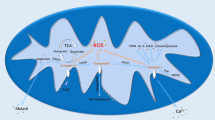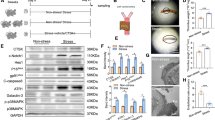Abstract
Abnormal hepatic iron metabolism is detrimental to health. The objective of this study was to detect repeated restraint stress on liver iron metabolism in rats. Twenty-four male rats aged 7 weeks were randomly divided into 2 groups: control group (Con) and repeated restraint stress group (RS). Rats were subjected to 6 h of daily restraint stress for 14 consecutive days in the repeated restraint stress group. The results showed that repeated restraint stress exposure decreased growth performance including impaired final weight (P = 0.07), reducing average daily gain (P = 0.01), and average daily feed intake (P = 0.00) during the 14-day experimental period. Repeated restraint stress exposure did not affect hemoglobin content and plasma iron parameters except downregulated unsaturated iron-binding capacity (P = 0.04). Repeated restraint stress exposure inhibited liver development (P = 0.03) and induced liver iron accumulation (P = 0.05). In addition, repeated restraint stress downregulated the expression of transferrin (TF) and transferrin receptor 2 (TFR2) at the mRNA level (P < 0.01), but upregulated at the protein level (P = 0.03 for TF; P = 0.00 for TFR2). These results indicated that repeated restraint stress induces hepatic iron accumulation, which is closely related to higher expression of hepatic TFR2 protein in rats.


Similar content being viewed by others
Abbreviations
- ADFI :
-
average daily feed intake
- ADG :
-
average daily gain
- ADII :
-
average daily iron intake
- Con:
-
control
- DMT1 :
-
divalent metal transporter
- FPN :
-
ferroportin
- FTH:
-
ferritin heavy chain
- FTL :
-
ferritin light chain
- HGB :
-
hemoglobin
- RS:
-
restraint stress
- TS :
-
transferrin saturation
- TIBC :
-
total iron-binding capacity
- TF :
-
transferrin
- Tf-Fe :
-
transferrin-bound iron
- TFR1 :
-
transferrin receptor 1
- TFR2 :
-
transferrin receptor 2
- UIBC :
-
unsaturated iron-binding capacity
- ZIP14 :
-
zrt/irt-like protein 14
References
Richardson DR, Lane DJ, Becker EM, Huang ML, Whitnall M, Suryo Rahmanto Y, Sheftel AD, Ponka P (2010) Mitochondrial iron trafficking and the integration of iron metabolism between the mitochondrion and cytosol. Proc Natl Acad Sci U S A 107:10775–10782. https://doi.org/10.1073/pnas.0912925107
Forth W, Rummel W (1973) Iron absorption. Physiol Rev 53:724–792. https://doi.org/10.1152/physrev.1973.53.3.724
Darshan D, Frazer DM, Anderson GJ (2010) Molecular basis of iron-loading disorders. Expert Rev Mol Med 12:e36. https://doi.org/10.1017/S1462399410001687
Clark MA, Goheen MM, Cerami C (2014) Influence of host iron status on Plasmodium falciparum infection. Front Pharmacol 5:84. https://doi.org/10.3389/fphar.2014.00084
Anderson CP, Shen M, Eisenstein RS, Leibold EA (2012) Mammalian iron metabolism and its control by iron regulatory proteins. Biochim Biophys Acta 1823:1468–1483. https://doi.org/10.1016/j.bbamcr.2012.05.010
Torti SV, Torti FM (2011) Ironing out cancer. Cancer Res 71:1511–1514. https://doi.org/10.1158/0008-5472.CAN-10-3614
Niederau C, Erhardt A, Haussinger D, Strohmeyer G (1999) Haemochromatosis and the liver. J Hepatol 30(Suppl 1):6–11
Woodman AG, Mah R, Keddie D, Noble RMN, Panahi S, Gragasin FS, Lemieux H, Bourque SL (2018) Prenatal iron deficiency causes sex-dependent mitochondrial dysfunction and oxidative stress in fetal rat kidneys and liver. FASEB J 32:3254–3263. https://doi.org/10.1096/fj.201701080R
Zhabyeyev P, Das SK, Basu R, Shen M, Patel VB, Kassiri Z, Oudit GY (2018) TIMP3 deficiency exacerbates iron overload-mediated cardiomyopathy and liver disease. Am J Physiol Heart Circ Physiol 314:H978–H990. https://doi.org/10.1152/ajpheart.00597.2017
Starkie RL, Hargreaves M, Rolland J, Febbraio MA (2005) Heat stress, cytokines, and the immune response to exercise. Brain Behav Immun 19:404–412. https://doi.org/10.1016/j.bbi.2005.03.005
Li M, Sun Q, Li S, Zhai Y, Wang J, Chen B, Lu J (2016) Chronic restraint stress reduces carbon tetrachloride-induced liver fibrosis. Exp Ther Med 11:2147–2152. https://doi.org/10.3892/etm.2016.3205
Bowers SL, Bilbo SD, Dhabhar FS, Nelson RJ (2008) Stressor-specific alterations in corticosterone and immune responses in mice. Brain Behav Immun 22:105–113. https://doi.org/10.1016/j.bbi.2007.07.012
Wei C, Zhou J, Huang X, Li M (2008) Effects of psychological stress on serum iron and erythropoiesis. Int J Hematol 88:52–56. https://doi.org/10.1007/s12185-008-0105-4
Zhao M, Liu L, Li X, Wang W, Wang L, Ma L, Shen H, Zhu Z, Li M (2014) Psychological stress leads to hepatic iron accumulation and disturbs iron homeostasis. J Chem Pharm Res 6:1128–1134
Huang K, Li H, Shen H, Li M (2012) Psychological stress expands low molecular weight iron pool in cerebral cortex, hippocampus, and striatum of rats. Biol Trace Elem Res 146:79–85. https://doi.org/10.1007/s12011-011-9230-7
Teng WF, Sun WM, Shi LF, Hou DD, Liu H (2008) Effects of restraint stress on iron, zinc, calcium, and magnesium whole blood levels in mice. Biol Trace Elem Res 121:243–248. https://doi.org/10.1007/s12011-007-8047-x
Li H, Jiang S, Yang C, Yang S, He B, Ma W, Zhao R (2017) Long-term dexamethasone exposure down-regulates hepatic TFR1 and reduces liver iron concentration in rats. Nutrients 9:617. https://doi.org/10.3390/nu9060617
Ball KT, Best O, Luo J, Miller LR (2017) Chronic restraint stress causes a delayed increase in responding for palatable food cues during forced abstinence via a dopamine D1-like receptor-mediated mechanism. Behav Brain Res 319:1–8. https://doi.org/10.1016/j.bbr.2016.11.020
Xu P, Wang K, Lu C, Dong L, Chen Y, Wang Q, Shi Z, Yang Y, Chen S, Liu X (2017) Effects of the chronic restraint stress induced depression on reward-related learning in rats. Behav Brain Res 321:185–192. https://doi.org/10.1016/j.bbr.2016.12.045
Ma W, Gu Y, Lu J, Yuan L, Zhao R (2014) Effects of chromium propionate on egg production, egg quality, plasma biochemical parameters, and egg chromium deposition in late-phase laying hens. Biol Trace Elem Res 157:113–119. https://doi.org/10.1007/s12011-013-9875-5
Marti O, Marti J, Armario A (1994) Effects of chronic stress on food intake in rats: influence of stressor intensity and duration of daily exposure. Physiol Behav 55:747–753
Gamaro GD, Manoli LP, Torrres IL, Silveira R, Dalmaz C (2003) Effects of chronic variate stress on feeding behavior and on monoamine levels in different rat brain structures. Neurochem Int 42:107–114
Chen J, Shen H, Chen C, Wang W, Yu S, Zhao M, Li M (2009) The effect of psychological stress on iron absorption in rats. BMC Gastroenterol 9:83. https://doi.org/10.1186/1471-230X-9-83
Ottenweller JE, Servatius RJ, Tapp WN, Drastal SD, Bergen MT, Natelson BH (1992) A chronic stress state in rats: effects of repeated stress on basal orticosterone and behavior. Physiol Behav 51:689–698
Rybkin II, Zhou Y, Volaufova J, Smagin GN, Ryan DH, Harris RB (1997) Effect of restraint stress on food intake and body weight is determined by time of day. Am J Phys 273:R1612–R1622. https://doi.org/10.1152/ajpregu.1997.273.5.R1612
Amin SN, El-Aidi AA, Zickri MB, Rashed LA, Hassan SS (2017) Hepatoprotective effect of blocking N-methyl-d-aspartate receptors in male albino rats exposed to acute and repeated restraint stress. Can J Physiol Pharmacol 95:721–731. https://doi.org/10.1139/cjpp-2016-0556
Dhabhar FS (2014) Effects of stress on immune function: The good, the bad, and the beautiful. Immunol Res 58:193–210. https://doi.org/10.1007/s12026-014-8517-0
Tao L, Zheng Y, Shen Z, Li Y, Tian X, Dou X, Qian J, Shen H (2013) Psychological stress-induced lower serum zinc and zinc redistribution in rats. Biol Trace Elem Res 155:65–71. https://doi.org/10.1007/s12011-013-9762-0
Santos J, Benjamin M, Yang PC, Prior T, Perdue MH (2000) Chronic stress impairs rat growth and jejunal epithelial barrier function role of mast cells. Am J Physiol Gastrointest Liver Physiol 278:G847–G854. https://doi.org/10.1152/ajpgi.2000.278.6.G847
Teague CR, Dhabhar FS, Barton RH, Beckwith-Hall B, Powell J, Cobain M, Singer B, McEwen BS, Lindon JC, Nicholson JK, Holmes E (2007) Metabonomic studies on the physiological effects of acute and chronic psychological stress in sprague-dawley rats. J Proteome Res 6:2080–2093. https://doi.org/10.1021/pr060412s
Papadimitriou A, Priftis KN (2009) Regulation of the hypothalamic-pituitary-adrenal axis. Neuroimmunomodulation 16:265–271. https://doi.org/10.1021/pr060412s
Grissom N, Bhatnagar S (2009) Habituation to repeated stress: get used to it. Neurobiol Learn Mem 92:215–224. https://doi.org/10.1016/j.nlm.2008.07.001
Herman JP (2013) Neural control of chronic stress adaptation. Front Behav Neurosci 7:61. https://doi.org/10.3389/fnbeh.2013.00061
Lawen A, Lane DJ (2013) Mammalian iron homeostasis in health and disease: uptake, storage, transport, and molecular mechanisms of action. Antioxid Redox Signal 18:2473–2507. https://doi.org/10.1089/ars.2011.4271
Kawabata H, Yang R, Hirama T, Vuong PT, Kawano S, Gombart AF, Koeffler HP (1999) Molecular cloning of transferrin receptor 2. A new member of the transferrin receptor-like family. J Biol Chem 274:20826–20832. https://doi.org/10.1074/jbc.274.30.20826
Graham RM, Reutens GM, Herbison CE, Delima RD, Chua AC, Olynyk JK, Trinder D (2008) Transferrin receptor 2 mediates uptake of transferrin-bound and non-transferrin-bound iron. J Hepatol 48:327–334. https://doi.org/10.1016/j.jhep.2007.10.009
Liuzzi JP, Aydemir F, Nam H, Knutson MD, Cousins RJ (2006) Zip14 (Slc39a14) mediates non-transferrin-bound iron uptake into cells. Proc Natl Acad Sci U S A 103:13612–13617. https://doi.org/10.1073/pnas.0606424103
Pinilla-Tenas JJ, Sparkman BK, Shawki A, Illing AC, Mitchell CJ, Zhao N, Liuzzi JP, Cousins RJ, Knutson MD, Mackenzie B (2011) Zip14 is a complex broad-scope metal-ion transporter whose functional properties support roles in the cellular uptake of zinc and nontransferrin-bound iron. Am J Phys Cell Phys 301:C862–C871. https://doi.org/10.1152/ajpcell.00479.2010
Nam H, Wang CY, Zhang L, Zhang W, Hojyo S, Fukada T, Knutson MD (2013) ZIP14 and DMT1 in the liver, pancreas, and heart are differentially regulated by iron deficiency and overload: implications for tissue iron uptake in iron-related disorders. Haematologica 98:1049–1057. https://doi.org/10.3324/haematol.2012.072314
Ponka P, Beaumont C, Richardson DR (1998) Function and regulation of transferrin and ferritin. Semin Hematol 35:35–54
Kawabata H (2019) Transferrin and transferrin receptors update. Free Radic Biol Med 133:46–54. https://doi.org/10.1016/j.freeradbiomed.2018.06.037
Funding
This work was supported by grants from the National Key Research and Development Program of China (2016YFD0500502); the National Natural Science Foundation of China (31872439); the Priority Academic Program Development of Jiangsu Higher Education Institutions; and the Jiangsu Collaborative Innovation Center of Meat Production and Processing, Quality and Safety Control.
Author information
Authors and Affiliations
Contributions
Ruqian Zhao, Yingdong Ni, and Wenqiang Ma conceived the project. Shihui Guo and Chun Yang carried out most experiments. Shuxia Jiang assisted animal experiment. Wenqiang Ma wrote the manuscript. The final version of the manuscript is approved by all co-authors.
Corresponding author
Ethics declarations
Conflict of Interest
The authors declare that they have no conflict of interest.
Additional information
Publisher’s Note
Springer Nature remains neutral with regard to jurisdictional claims in published maps and institutional affiliations.
Rights and permissions
About this article
Cite this article
Guo, S., Yang, C., Jiang, S. et al. Repeated Restraint Stress Enhances Hepatic TFR2 Expression and Induces Hepatic Iron Accumulation in Rats. Biol Trace Elem Res 196, 590–596 (2020). https://doi.org/10.1007/s12011-019-01956-4
Received:
Accepted:
Published:
Issue Date:
DOI: https://doi.org/10.1007/s12011-019-01956-4




